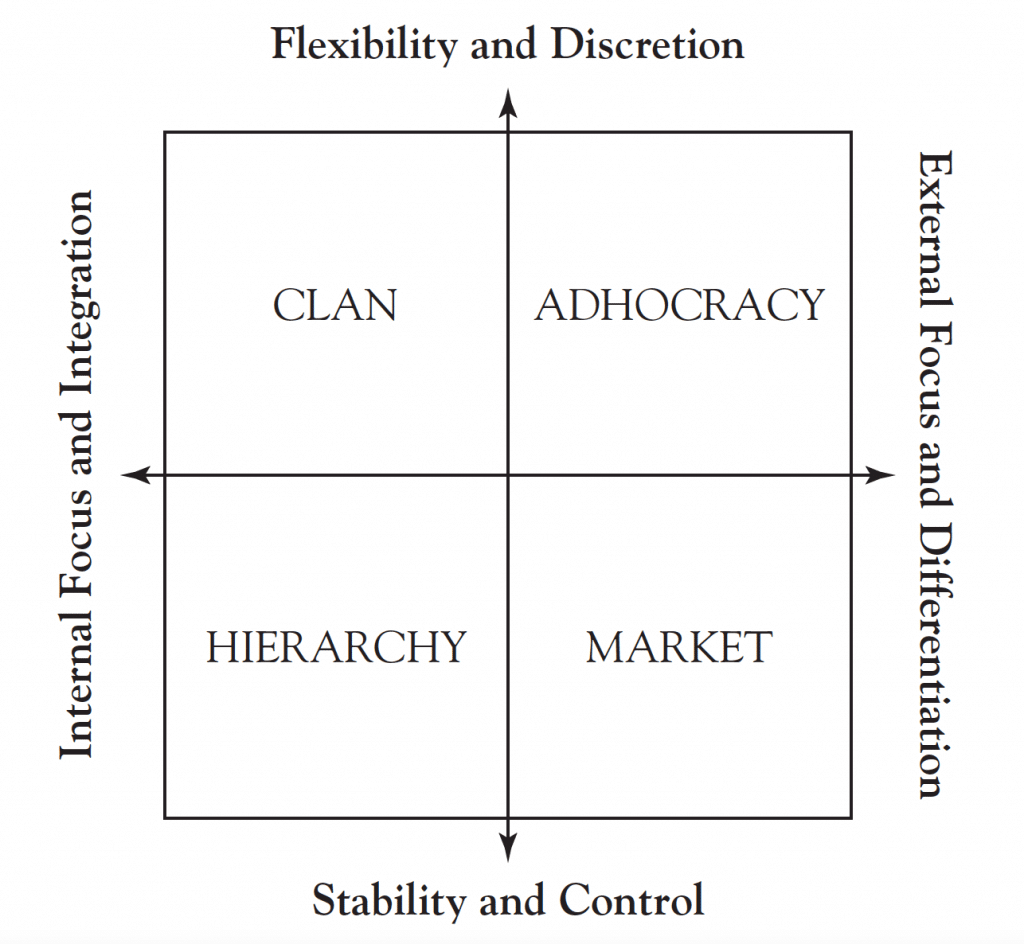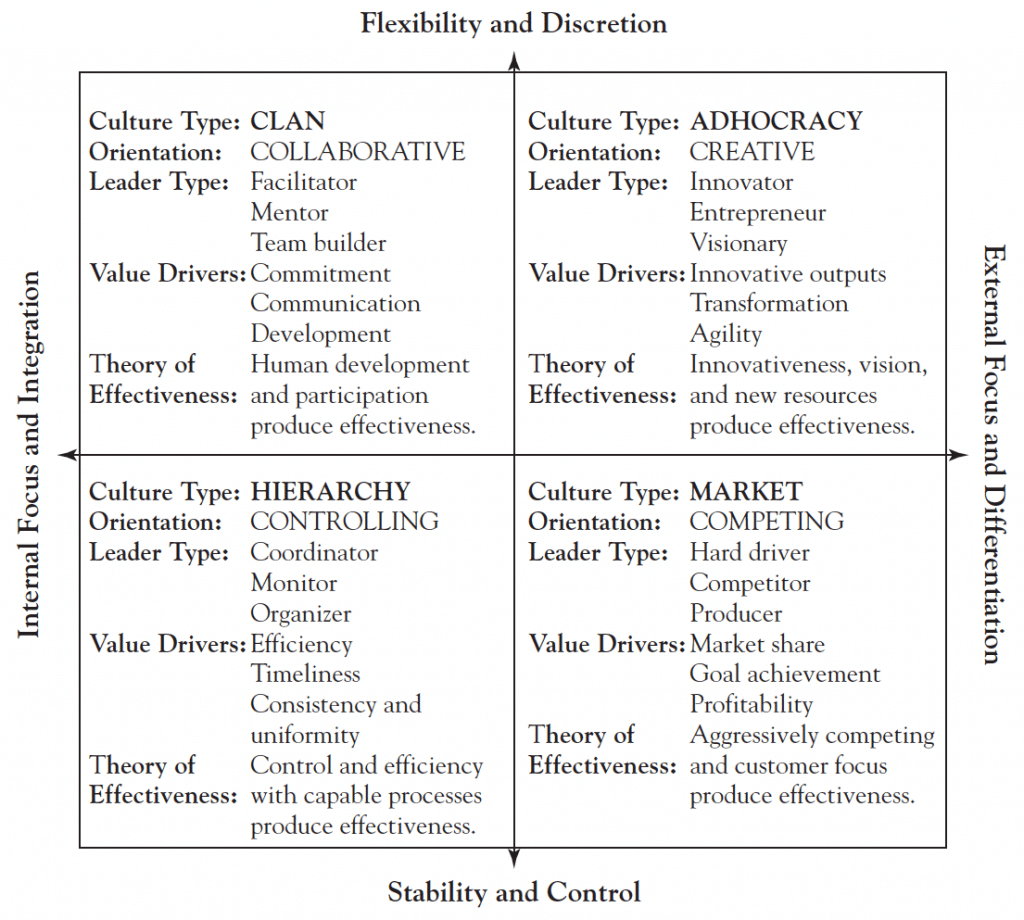
Which Culture is Right For Your Company?
Think of culture as an organization’s human operation system that guides everyone’s intuitions and drives behavior. Build a strong operating system and you’ll achieve predictable results. However, the nature of the results depends entirely on the organizational culture that leaders support.
The key to leadership success is to pick one that matches with your target market.
In researching this topic, I’ve looked for work which isolate distinct types of cultures, what creates them and more importantly, what results they produce. My favorite finding is research conducted by Robert Quinn and Kim Cameron at the University of Michigan, where they isolated four types of corporate culture, based on their competing values framework.
- Clan (Relationships)
- Adhocracy (Innovation)
- Market (Competition)
- Hierarchy (Stability)
As you look at this list, you might be thinking, “I see the one we should have!” But my question to you is “Why?” Much like company values, we often choose cultural constructs for our organization based on our personal experiences or affinities. If you fancy yourself a creative person, innovation may be your natural choice. If you are all about the Love, then the relationships culture would be your go-to as a leader.
Here’s where the problem lies: Sometimes your personal values don’t translate into culture-market fit. If you have an affinity for stability and leverage, you might choose the Hierarchy approach. (Especially if you are old-school.) If you were running a software company, that would be a #fail because the tech services market is driven by innovation, where temporary instability is accepted as the price of being a pioneer.
Most cultures are based on shared values, often originating with the founder or new leadership. If they are truly winning values which drives the business, then they help differentiate the company in a way that stakeholders really care about. That can include clients, employees or business partners.
The key then, is to pick a culture that fits the nature of the market that your company does business in and resonates with your stakeholders. Here’s how you can think about the four culture types and determine which one is for you. First, let’s take a look at the competing values framework that Quinn and Cameron came up with: 
Clan (Relationships)
These firms feel like an extended family. Shared values and teamwork are the glue that holds these organizations together. Everyone from talent to customer to supplier are considered partners. Development is a top priority for the organization.
This culture is effective in a market where loyalty, customer experience, service excellence and value focused problem solving are top business drivers. Examples include sales and marketing driven organizations in relatively stable environments where CRM is the top priority.
Adhocracy (Innovation)
These companies believe they exist to launch new products, prepare for the future and win through creativity. They believe that most business plans are temporary and subject to disruption. They champion change and believe customers will value cutting edge over smooth-and-steady.
This culture is effective when they operate in a quickly developing market or a market that’s experience turbulent changes due to technology or external factors. Companies in this culture measure success by their innovation index, which measure percentage of sales based on newly introduced products. Examples include software companies, certain consumer goods companies like cosmetics and more recently, transportation and lodging.
Market (Competition)
These companies believe in winning through developing an advantage in the area of transaction costs. They believe that the world is a dangerous place, where competitors are working night and day to defeat them. They champion George Patton’s perspective: “Market organizations are not interested in holding their positions. Let the enemy do that. They are advancing all the time, defeating the opposition, marching constantly toward the goal.”
This is a winning cultural choice in markets where profitability is rewarded to only the few companies at the top. Jack Welch famously led GE to only be in markets where they are number one or two for this reason. Modern examples include Google in internet search, Hewlett Packard in printers or Raytheon in defense contracting.
Hierarchy (Stability)
These companies value efficiency and predictable results above all – especially when it comes to the reliability and quality of their products. They believe that employee actions should be meticulously designed and enforced to the letter of the procedure. The best leaders have organizational skills, know how to coordinate people and stuff and most of all – possess a respect for formality.
This is an often outdated way to approach markets today and produces success in highly stable and mature industries where the impact of loyalty and innovation pale in comparison to the primacy of consistency. Modern examples include line-driven quick service food such as McDonald’s, legacy government agencies and certain manufacturing industries where quality outstrips innovation as a value-driver.
In their book Diagnosing and Changing Organizational Culture, Quinn and Cameron expand on their organizational framework, putting together this meaty graph below.

Take a minute to look at these four options in order to find a good fit for the values and leadership style that resonate with you and your team, but most importantly, take your market dynamics into account. If you’ve prioritized Relationships over Innovation, but your market is being disrupted daily, your personal values may put you out of business!
That’s why it’s important to be highly adaptive as a leader, so that your company can stay in tune with the times. For example, although the auto industry has been hierarchy to market culture over the last century, those that gravitate to Adhocracy just may survive the triangulation of shared rides, driverless vehicles and sustainability.
My favorite way of defining corporate culture is by describing it as a conversation, led by leaders about ‘how we do things here successfully and what we want to achieve.’ The conversation becomes highly influential when it’s backed up by actions and investments.
If your existing culture is right for your market, make sure and lead the conversation to focus on the value drivers in the graph above. If you need to pivot to a new culture because of your market, learn to shift the conversation, starting with your leadership style.
Sometimes cultures have to change pretty quickly. Current examples include Ford, Wells Fargo and Microsoft. The key is to educate everyone around you about the market, what it’s going to take to thrive in it, and how every person can contribute the new culture — and the future of the company.
